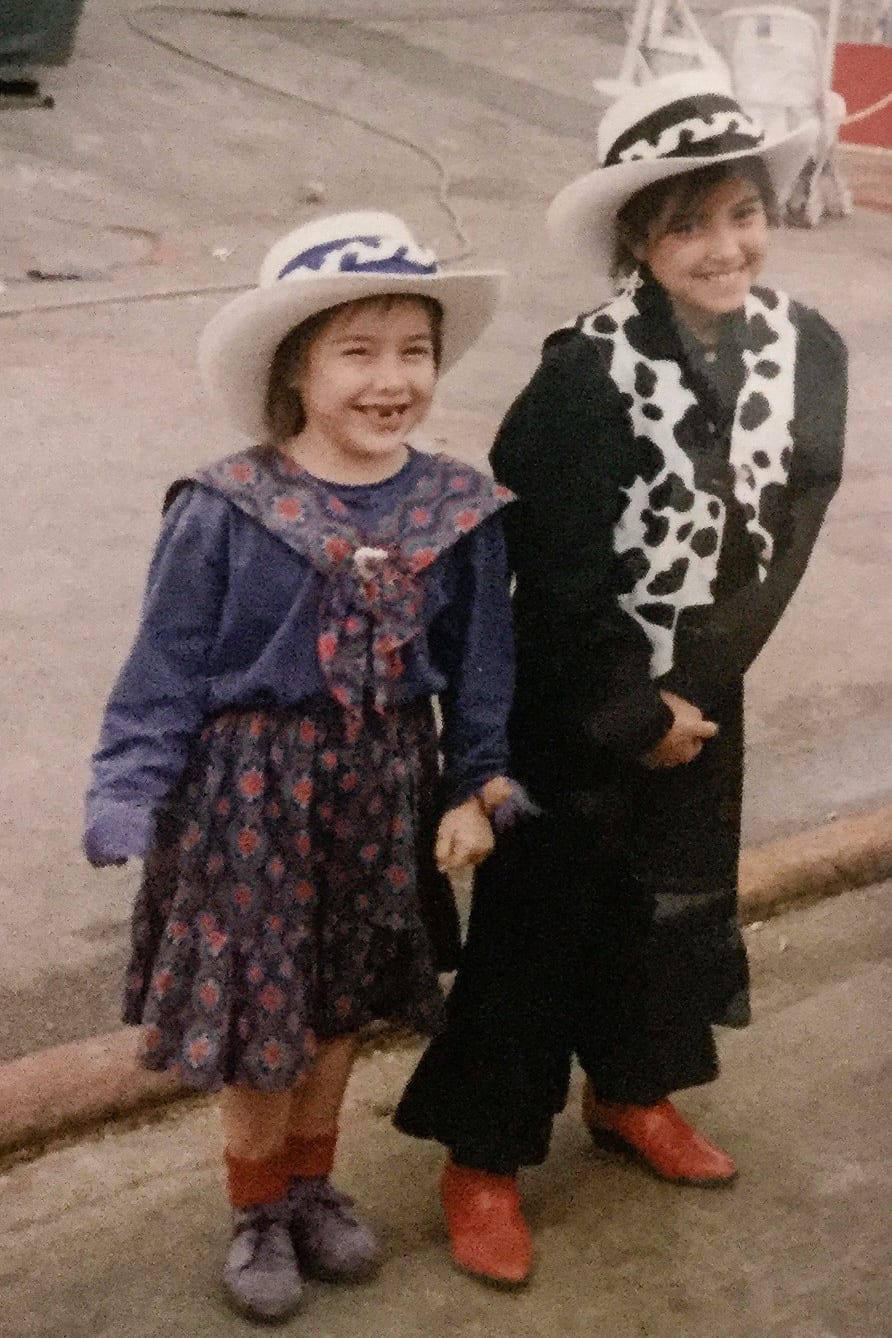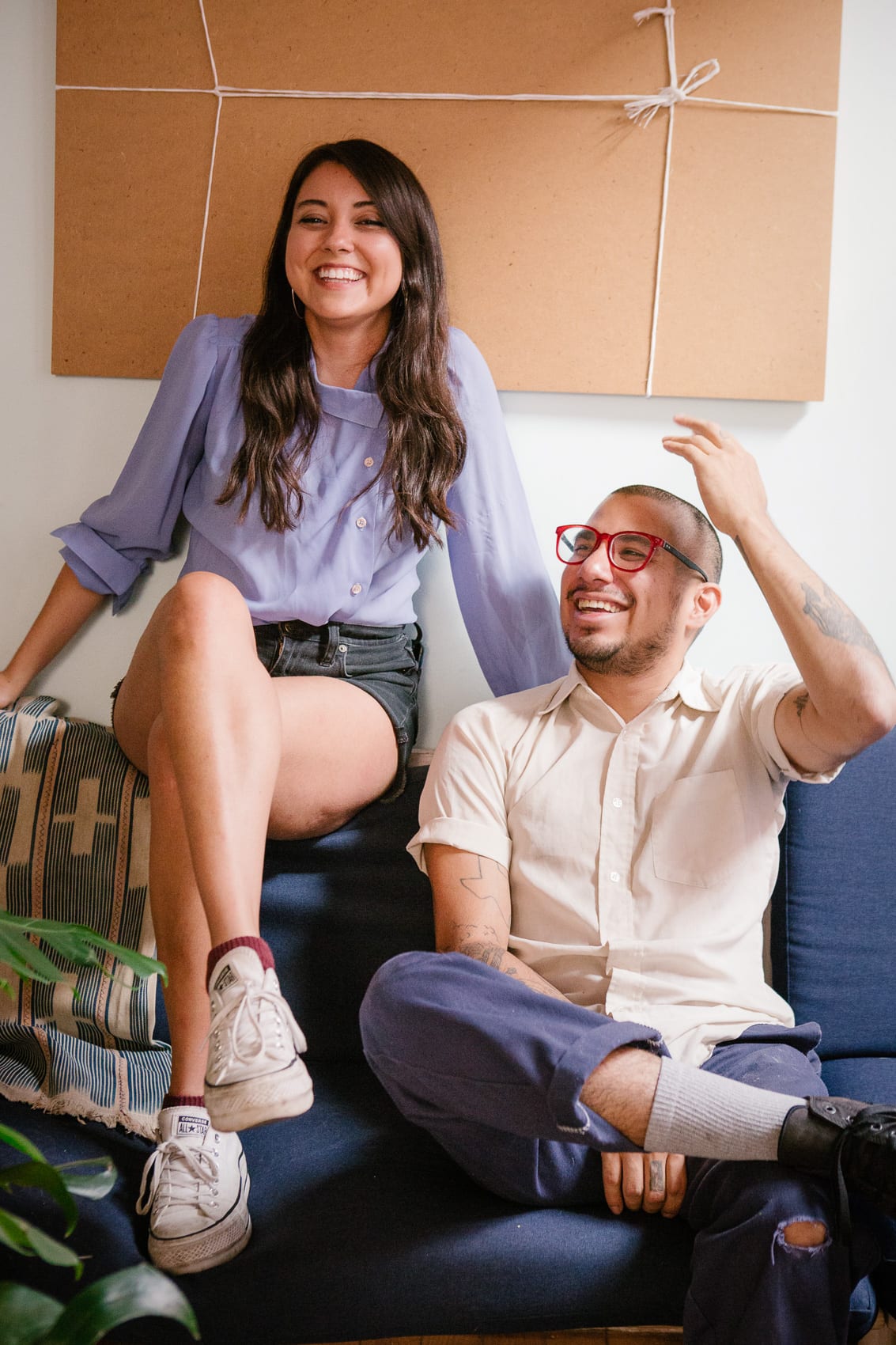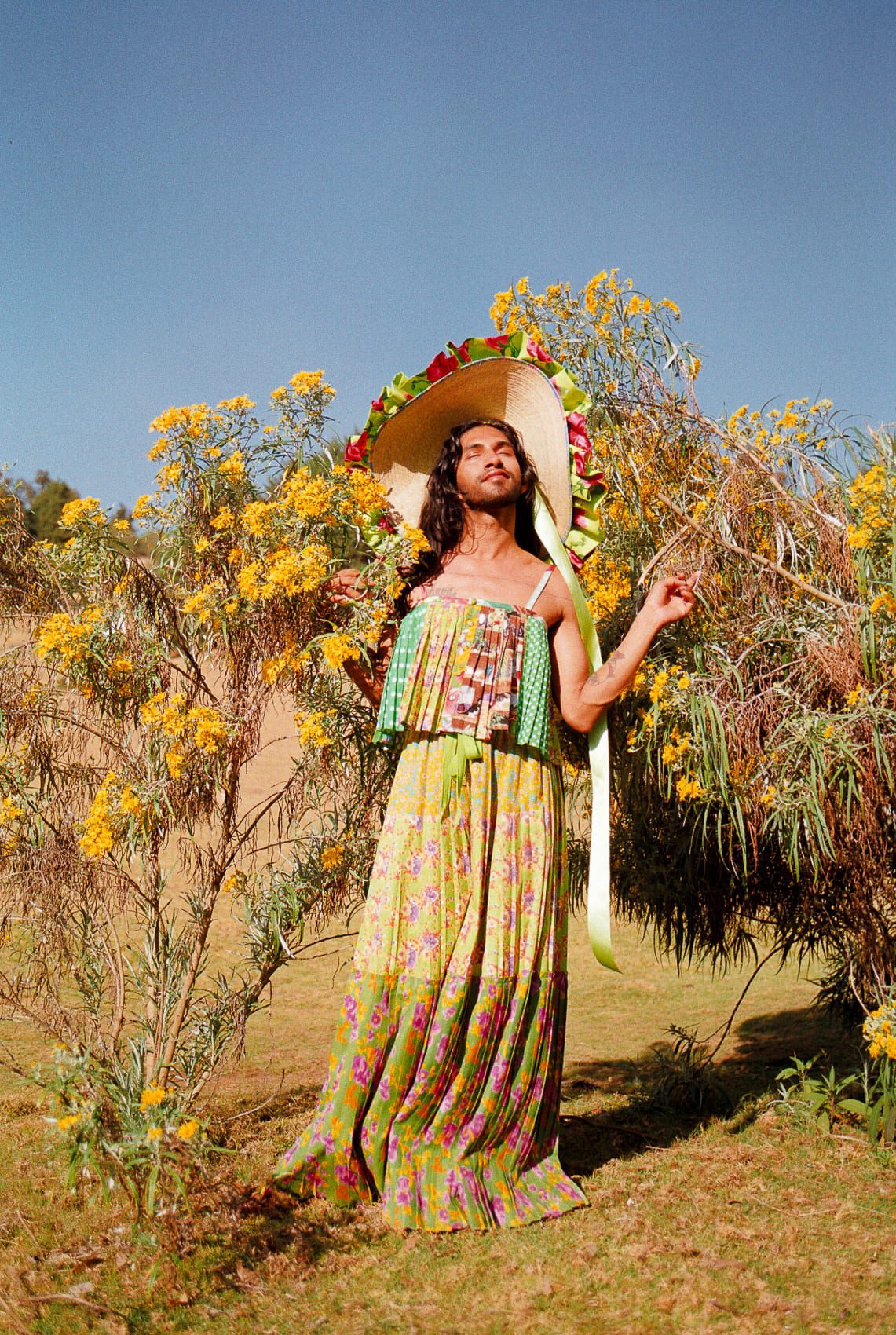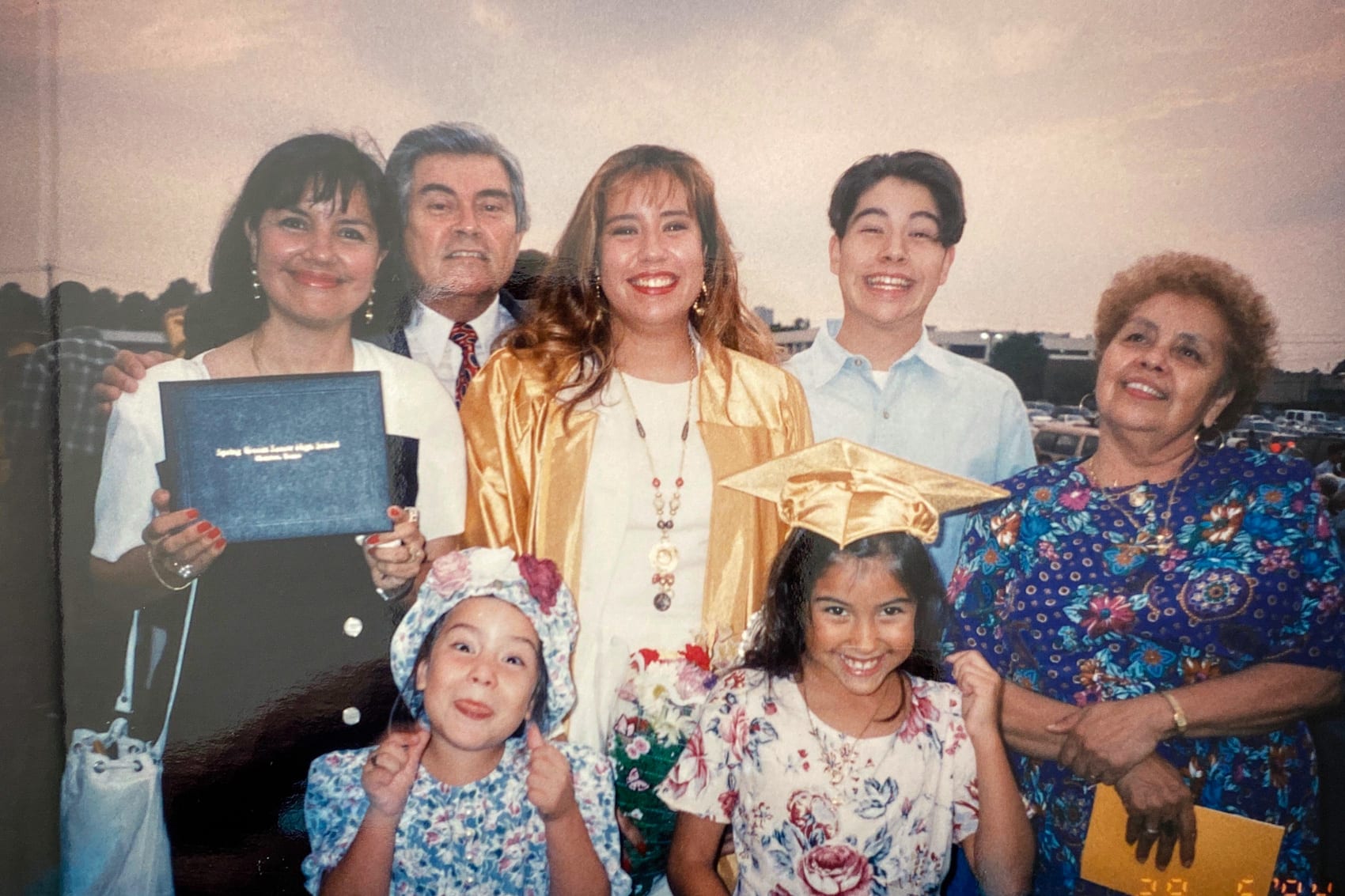 Foto de Andres Navarro
Foto de Andres NavarroEn los últimos años se ha trasladado más gente de Estados Unidos a México que a la inversa, lo que ha contribuido a mezclar aún más las culturas y comunidades de los países vecinos.
Arriba: Jesús Herrera modelando Les Jesus, una marca de moda basada en la artesanía tradicional mexicana que cofundó con su marido. Herrera es un diseñador de moda y modelo cuya familia cruzó la frontera sin documentos cuando él tenía seis años y se estableció en Rockford, Illinois. Herrera decidió volver a México en 2010 y fue uno de los 1,1 millones de mexicanos que regresaron voluntariamente entre 2010 y 2018. Foto de Andrés Navarro
Triplique hoy su impacto. Entre el 1 de noviembre y el 31 de diciembre, NewsMatch igualará su nueva donación mensual 12 veces o triplicará su donación única, todo ello hasta $5.000. Donar
Lisa Saldívar pidió la comida en una esquina de Ciudad de México un día nublado de agosto. Su quesadilla vino acompañada de una broma amistosa del vendedor sobre su español imperfecto. Como muchos hijos estadounidenses de inmigrantes mexicanos, creció en un hogar donde los miembros de la familia le hablaban en español y ella respondía en inglés.
Cuando era una niña que intentaba encajar como mexicano-americana de primera generación en Texas, nunca imaginó que su acento americanizado la llevaría a intentar encajar de nuevo como adulta, sólo que esta vez en Ciudad de México, México.
Entender cómo generaciones de familias inmigrantes como la suya se integran en la vida de Estados Unidos es la motivación que hay detrás de Asimilación inversaun podcast que Saldivar creó con el artista de collage de técnica mixta Jay Berrones.
Saldivar es ilustrador y diseñador gráfico que se trasladó de Estados Unidos a México. Ella es parte de un aumento de la migración inversa en la última década que ha dado lugar a un estimado 1,5 millones de estadounidenses vive actualmente en México. Más personas se han trasladado a México de Estados Unidos en los últimos años que a la inversa.
Algunos de los estadounidenses que se trasladan a México siguen a sus familiares indocumentados. Los inmigrantes mexicanos que viven en Estados Unidos sin papeles han regresado cada vez más a su país en la estela de la economía estadounidense lenta recuperación de la recesión de 2008. Otros son los jubilados estiran sus pensiones o trabajadores a distancia que quieran disfrutar de un clima más cálido.

Lisa Saldivar y Lindsey Saldivar asisten a un rodeo en Houston, Texas, en febrero de 1992. Foto cortesía de Lisa Saldivar.
Otros, como Saldivar, se trasladan a México para intentar conectar con las raíces de su familia. Cuando se mudó en 2016, esperaba completar lo que sentía que faltaba en su identidad. Pero la realidad de ese esfuerzo, descubrió, es complicada.
"En Estados Unidos siempre sentí que no era lo bastante estadounidense, y en cuanto llegué aquí sentí que no era lo bastante mexicana", dice.
Cuando pasó un camión meticulosamente cargado con una montaña de cosas apiladas de al menos tres metros de altura, Saldívar se echó a reír en plena calle.
"Me acordaba de todas las peleas en las que se metían mi abuela y mi padre cuando nos íbamos de vacaciones, porque hacían eso: Jenga juntos en esta loca situación", dice. "Estoy viendo dónde mis padres y abuelos habían aprendido estas cosas que en Estados Unidos eran simplemente algo que no querría contar a los niños en la escuela".
Estos momentos de frustración y revelación son el tema de Asimilación inversaque se inició gracias al encuentro entre Saldívar y Berrones tras alquilar estudios en el espacio para artistas Los Catorce, una mansión en ruinas y técnicamente condenada en el barrio de San Rafael de Ciudad de México.
Tras meses de tímidos saludos de "¿Qué onda?" - cada uno suponiendo que el otro había nacido y crecido en México - finalmente se dieron cuenta de que en realidad ambos habían crecido en Houston y se habían trasladado a Ciudad de México. Ambos tomaron la decisión en parte por la necesidad de responder a preguntas sobre su herencia.

Lisa Saldivar y Jay Berrones, co-creadores del podcast Reverse Assimilation, el 18 de mayo de 2020 en el espacio para artistas Los Catorce - una mansión en ruinas y técnicamente condenada en el barrio de San Rafael. Foto de Alicia Vera
El día que se dieron cuenta hablaron durante cuatro horas.
"De hecho, creo que a las dos o tres horas estaba en plan: '¿Queréis agua?', porque no parábamos de hablar", dice Saldívar.
"Toda la conversación estaba plagada de 'creía que era el único'", dice Berrones, mexicano-americano de tercera generación cuya familia se cruzó por la frontera cuando México perdió la mitad de su territorio en favor de Estados Unidos en 1848.
Se identificó con la sensación de Saldívar de borrado cultural a lo largo de generaciones.
"Cuando mi madre crecía en casa de mis abuelos, no podías girar a ningún lado sin ver a la Virgen de Guadalupe", dice. "Pero ella me enseñó: 'Nosotros no hacemos eso'".
En la primera entrega de seis episodios del archivo de audio, publicada en septiembre, Saldívar y Berrones mantienen conversaciones francas con cuatro artistas mexicano-americanos del sur de California, el Medio Oeste, Miami y las zonas fronterizas que se han encontrado viviendo en Ciudad de México.
"Estábamos rodeados de otros artistas mexicano-estadounidenses, y cuando salía este tema en las fiestas, veíamos que a los demás se les iluminaban los ojos; tenían mucho que decir", dice Saldívar. "Ya estábamos teniendo estas conversaciones, todo lo que necesitábamos era proporcionar una estructura para ello".
Las entrevistas consisten en un intercambio de anécdotas y preguntas entre mexicano-americanos que desgranan las variadas experiencias de asimilación de sus respectivas familias a la cultura blanca estadounidense. Aunque Saldívar y Berrones subrayan que la asimilación no es culpa de nadie ni es inherentemente negativa, afirman que puede llegar a ser problemática cuando se produce a costa de la pérdida de expresión cultural.
Jesús Herrera es un diseñador de moda y modelo cuya familia cruzó la frontera sin documentos cuando él tenía seis años y se instaló en Rockford, Illinois.
"No puedes mantener presentes las dos [tu identidad mexicana y tu identidad estadounidense]; tienes que renunciar a una para poder hacer bien una", dice Herrera, en el segundo episodio del podcast. Así que me convertí en un 'buen americano' -lo que quiera que eso signifique- y me convertí en un 'mal mexicano'".
Saldívar y Berrones hacen referencia al espectro de asimilación expuesto por el sociólogo estadounidense Milton Gordon en 1964. Describe un proceso de siete etapas que, a grandes rasgos, incluyen la adopción de costumbres cotidianas, la entrada en la esfera pública, los matrimonios mixtos, el uso del inglés como lengua dominante en el hogar y el cambio de actitudes y creencias, "a veces hasta el punto de defender actitudes construidas para borrar la propia identidad cultural."
Asimilación inversa es el intento de Saldívar y Berrones de situarse en ese espectro y luego deconstruirlo.
"Lo veo como desaprender y descolonizar el crecer en una sociedad basada en creencias supremacistas blancas", dice Saldivar.
Herrera dice que crecer en la comunidad latina de una pequeña ciudad de Illinois era "un mundo dentro de otro mundo".
"Luego, la siguiente capa fuera de eso era conservadora y blanca", dice.
Pocos meses después de emigrar a Estados Unidos, un compañero de clase señaló sus sandalias huaraches. A partir de ese día tomó la decisión consciente de pasar desapercibido.
"Todo lo que había en la escuela era Britney Spears. Sinceramente, me encantaba porque era muy diferente de lo que vivía en casa, donde veíamos Telemundo y Univisión", dice Herrera.
Pero además, como niño marica, indocumentado, moreno y con un nombre casi blasfemo, no era seguro destacar.
"Había una gran incertidumbre cada vez que se hacía una redada en una fábrica", afirma Herrera.
Cuando terminó el bachillerato, Herrera se dio cuenta de que, aunque se endeudara para obtener un título universitario, seguiría sin tener los papeles necesarios para la mayoría de los trabajos.
"Sentía que no podía ejercer toda mi humanidad en Estados Unidos", dice.
Herrera decidió regresar a México en 2010 y fue uno de los 1,1 millones de mexicanos que regresaron voluntariamente entre 2010 y 2018. Sin embargo, el término "retornado voluntario" no refleja el trauma del exilio que sufren muchos.
Herrera no pudo conseguir un visado para entrar legalmente en Estados Unidos y ver a su familia durante ocho años, hasta que se casó con su marido estadounidense. Juntos, Herrera y su marido fundaron Les Jesus, una marca de moda basada en la artesanía tradicional mexicana.
"Nuestra marca es una celebración de otros colores, sexualidades, queerness, posibilidades", dice Herrera.

Jesús Herrera modelando Les Jesus, una marca de moda basada en la artesanía tradicional mexicana que cofundó con su marido. Foto de Andres Navarro
También es un reflejo de la pluralidad de su identidad, que llegó tras años de introspección y asimilación inversa, en gran parte debido a la obtención de la tarjeta verde y a que ya no tenía que ocultar su situación legal.
"Antes de eso, intentaba separar los dos yo: ¿cuál yo es mexicano? ¿Cuál es el americano? Luego me di cuenta de que están tan mezclados que da igual", dice Herrera.
La jerga mexicana colorea el Asimilación inversa conversaciones, pero el podcast está mayoritariamente en inglés. Es un reflejo de la audiencia a la que Saldivar y Berrones esperan llegar.
"Si vamos a hablar de asimilación inversa, tenemos que tener algo a partir de lo cual invertir", dice Berrones. "Nuestra lengua hablada es ante todo un indicio de nuestro punto de asimilación".
Después de vivir en el país, Saldívar y Berrones no creen que regresar a México sea esencial para abrazar su "mexicanidad". Su intención ahora es inspirar conversaciones entre sus familiares y amigos en Estados Unidos.
"Siempre fui muy consciente de querer que esto fuera para el Chicanx comunidad", afirma Lisa. Independientemente de que su público se identifique o no con ese término, el fomento de la exploración de la Chicanismo se ha convertido en una motivación involuntaria para el dúo.
El podcast está enmarcado con audio y música de archivo de un reportaje de la CBS de 1971 titulado Chicanoque analiza las protestas del movimiento chicano en los años 60 y 70 contra la brutalidad policial.
Mientras los artistas trabajaban en el podcast en el verano de 2020, se convirtió en un potente símbolo de lo mucho que aún no ha cambiado en Estados Unidos.
La división que Saldívar y Berrones descubrieron en torno al término Chicanx - que el Movimiento Chicano recuperó de un insulto étnico para representar el orgullo, el empoderamiento y la solidaridad entre los hijos estadounidenses de inmigrantes mexicanos que rechazaron la asimilación cultural, representa las barreras que están trabajando para superar con el fin de abrazar plenamente sus identidades.
"La generación de nuestros padres lo veía como una rebelión. Un movimiento al que no querían asociarse. Intentaban pasar desapercibidos y abrirse camino hacia su propia versión del éxito en la cultura estadounidense", dice Saldivar.

Elva, Raúl, Lori, Lindsey, Lisa, Raúl y Lorenza asisten a la graduación de Lori de la Escuela Secundaria Springwoods en 1994. Foto cortesía de Lisa Saldivar.
"No sabía cómo asociar mi nombre a la palabra Chicano y abrazarlo de verdad antes de este proyecto", dice Berrones. "En El Manifiesto Chicanouna de las frases más conmovedoras es que Chicanismo es un estado mental iluminado".
Esa iluminación se alcanza tras años de lucha, dice Sadivar.
Y es esa lucha interna la que Asimilación inversa a través de la conversación con la comunidad. Algún día, Saldívar y Berrones esperan que el proyecto se convierta en una exposición de arte visual de artistas mexicano-americanos que trabajen en torno al tema de la identidad bicultural.
Durante años, Saldivar ha estado obsesionado con encontrar una forma de representar visualmente las muchas maneras en que la gente experimenta el espectro de la asimilación inversa. "Una de las cosas que más me ha llamado la atención es la idea de que se convierta más en una espiral que en un espectro lineal. Que puedes estar en dos puntos diferentes al mismo tiempo", dice Saldivar.
Para Herrera, las conversaciones al respecto fueron profundamente sanadoras.
"En el podcast pude sacar cosas de mi infancia que no había vocalizado con nadie", dice Herrera. "Fue muy liberador".
